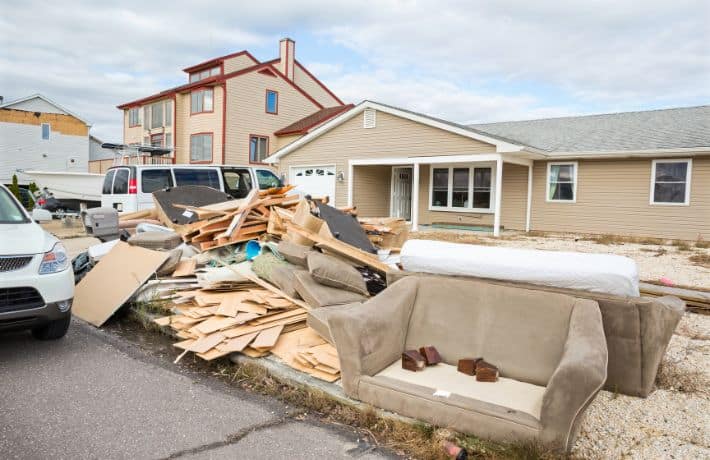GAO: Federal Approach to Disaster Recovery Is Fragmented, Difficult to Navigate

Each year, disasters such as floods, hurricanes, and wildfires affect hundreds of communities across the nation, and the federal government steps in to support state, local, tribal, and territorial governments with their short- and long-term recovery efforts. Since 2005, federal funding for disaster assistance has totaled roughly $600 billion, and the rising number of natural disasters and increasing reliance on the federal government for assistance is a key source of federal fiscal exposure.
Researchers from the Government Accountability Office recently examined the federal government’s response to disaster recovery and found a highly fragmented approach that creates challenges for state and local officials trying to navigate across multiple federal recovery programs with different requirements and time frames; multiple federal authorities; and limited data sharing. These officials also noted that such challenges make it harder for communities — and particularly lower income areas — to successfully navigate multiple federal programs. Congress and federal agencies have taken steps to address aspects of these challenges — by creating interagency agreements to increase communication and by reducing program complexity — but the challenges remain, according to the GAO.
These conclusions come following interviews with federal, state, and local officials, and a panel of experts, as well as a review of relevant statutes and regulations, such as the Robert T. Stafford Disaster Relief and Emergency Assistance Act (Stafford Act), and interagency coordination documents, such as the National Disaster Recovery Framework. As part of the assessment, GAO researchers also looked at five key federal post-disaster programs: FEMA’s Public Assistance and HMGP programs; the Department of Housing and Urban Development’s (HUD) Community Development Block Grant Disaster Recovery (CDBG-DR) and Mitigation (CDBG-MIT); and the Federal Transit Administration’s (FTA) Public Transportation Emergency Relief Program within the Department of Transportation (DOT).
In its 100-page report, Disaster Recovery: Actions Needed to Improve the Federal Approach, the GAO notes that the current federal approach is, in many ways, a byproduct of 40+ years of incremental efforts to address emerging issues in disaster recovery through legislative reform as well as differing agency regulations and policies —leaving no single federal agency or Congressional committee responsibility for managing the system as a whole. At the present, there are more than 30 federal agencies and departments involved in disaster recovery and at least 32 congressional committees with responsibility for overseeing federal disaster recovery programs. The GAO recommends that Congress consider establishing an independent commission to recommend reforms to the federal government’s approach to disaster recovery, which may include the options identified in this report.
Options to Improve the Federal Government’s Approach to Disaster Recovery
In addition to the independent commission, the GAO identified 11 options that could improve the federal approach to disaster recovery. Determining the best option(s) requires complex tradeoff decisions, and the report outlines the strengths and weaknesses of each of the following options:
- Develop new efforts to clearly and consistently communicate about recovery programs.
- Provide coordinated technical assistance throughout disaster recovery.
- Develop models to more effectively coordinate across disaster recovery programs.
- Develop a single online application portal for disaster recovery that feeds into one repository.
- Standardize requirements of federal disaster recovery programs.
- Simplify requirements of federal disaster recovery programs.
- Further incentivize investments in disaster resilience as part of federal recovery programs.
- Identify desired recovery outcomes and develop a mechanism to track these across programs.
- Prioritize disaster recovery funding for vulnerable communities across all federal programs.
- Consolidate federal disaster recovery programs.
- Adjust the role of the federal government in disaster recovery.
Here’s Our Take
This report shines a light on something ASFPM members know all too well — navigating federal assistance programs is a huge challenge in the best of times and incredibly burdensome during post-disaster recovery. Of the 11 options presented, #7, with its emphasis on incentivizing investment in resilience at the state and local level is one that jumps out at us. This is a critical component to any sound disaster recovery plan as it will help protect communities against future climate-related disasters and reduce federal exposure and taxpayer burden.
In 2017, FEMA proposed the implementation of a Public Assistance deductible that would reward states for undertaking mitigation activities to boost resilience to future disasters, thereby reducing future disaster costs nationally. This was an approach that ASFPM strongly supports and we explained our rationale in comments submitted to Regulations.gov at the time.
In those comments, we noted our concerns that the nation’s disaster relief program is not being used effectively to build state capability to mitigate hazards. Instead, it has created an atmosphere where some states are taking fewer steps and investments to mitigate existing hazards or prevent creating new hazards because they believe federal taxpayers will pay for most of the disaster costs when disaster strikes.
Too many states have come to believe natural disasters are the problem of the federal government, when actually, public safety is the primary responsibility of state and local governments that have authority to guide development to be at more or be less at risk to natural hazards. States must provide local governments with the authority, technical assistance, and support to become resilient, and we were disappointed this newly released GAO report doesn’t address the key role states must play.
Download the report Disaster Recovery: Actions Needed to Improve the Federal Approach
Other GOA Reports of Interest:
This new report is the latest in a flurry of other GAO reports that might be of interest to ASFPM members. In the November issue of The Insider, we provided a detailed summary of the report on how the property acquisition process could be improved. Download Flood Mitigation: Actions Needed to Improve Use of FEMA Property Acquisitions here.
Other reports include:


